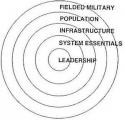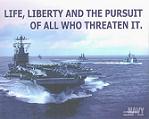Yet how do Chinese experts envision the “kill chain”— the sequence of events that must occur for a missile to successfully engage and destroy or disable its target (e.g. an aircraft carrier)—beyond the five steps that they commonly list: 1)
detection, 2)
tracking, 3)
penetration of target defences, 4)
hitting a moving target, and 5) causing sufficient
damage? A single broken link would render an attack incomplete, and hence ineffective. [...]
While locating an aircraft carrier has been likened to finding a needle in a haystack, this particular needle has a large radar cross section, emits radio waves, and is surrounded by airplanes. Active radar is the most likely ASBM sensor, since its signals can penetrate through clouds. Simply looking for the biggest reflection will tend to locate the largest ship as a target, and the largest ship will usually be an aircraft carrier (if the pre-launch targeting was good).[...]
How are sensors prioritized and coordinated? Which organization(s) control which sensors (e.g. OTH radar), and how are they used? Is there a risk of seams between services (e.g. Second Artillery, Navy, etc.)? What about problems with bureaucratic “stovepipes,” particularly during general wartime crisis management? How to overlap areas of “uncertainty” from different sensors, and thereby accomplish data/sensor fusion? How to accomplish bureaucratic “data fusion”—a task beyond even the most competent engineers? Finally, which authorities would need to be in the decision-making loop, and what are the time-to-launch implications?[...]
According to its handbook, the Second Artillery is thinking seriously about at least five ways to use ASBMs against U.S. CSGs, at least at the conceptual level:
• “Firepower harassment [strikes]” (
huoli xirao) involve hitting carrier strike groups.
• “Frontal firepower deterrence” (
qianfang huoli shezu) involves firing intimidation salvos in front of a carrier strike group “to serve as a warning.”
• “Flank firepower expulsion” (
yice huoli qugan) combines interception of a carrier strike group by Chinese naval forces with intimidation salvos designed to direct it away from the areas where China feels most threatened.
• “Concentrated fire assault” (
jihuo tuji) involves striking the enemy’s core carrier as with a ‘heavy hammer.’
• “Information assault” (
xinxi gongji) entails attacking the carrier strike group’s command and control system electromagnetically to disable it.[...]
Still, this leaves critical questions unanswered concerning how the PLA might envision the basing location, number, employment, and strategic effects of any ASBMs:
•
Base of operations. Where would the ASBMs themselves be based? What would be the expected range from the target?
•
Nature of arsenal. What would be the relative size of the ASBM inventory? Size might have implications for operational possibilities and willingness to expend ASBMs in conflict.
•
Concept of operations. It is one thing to call for ASBM capabilities, but how would they be realized in practice? What would an ASBM firing doctrine look like, and what would be the objective? Target destruction or mission kill (the equivalent of ‘slashing the tires’ on carrier aircraft)? What to shoot at, and when? Would the PLA fire on a carrier if it knew the planes were off of it? Would it rely on a first strike? Would the PLA plan to fire one ASBM, several, or a large salvo? If a salvo, then some combination of saturation (many shots in the same space, to overload missile defence), precision (firing many shots in a pattern to compensate for locating error on the target and to get the CSG in the seeker window of at least one of the missiles), or both? What type of warhead: unitary, EMP, or sub-munitions? How might salvo attacks, or multi-axis attack coordination, be envisioned? Do Chinese planners think that the Second Artillery could handle the mission by itself, or would it be part of a high-low, time-on-target attack with both ASBMs and cruise missiles?
•
Concept of deterrence. Deterrence would seem to be a clear purpose of any ASBM development, but what does one have to show to deter? PLA doctrinal publications mention firing ‘warning shots’ in front of carriers—how does the Second Artillery think the United States would respond? How would the United States know it was a warning shot and not just a miss? What if the United States did know and called China’s bluff? Finally, from a technical perspective, how to actually fire a warning shot and miss by an intentional margin (versus having the seeker home in on the actual target)? [...]
From Chinese sources, it can be inferred that Chinese leaders seek not to attack the United States, but to deter it. They want to defend what they perceive to be their state’s core territorial interests and to ensure a stable environment for domestic economic development. If they develop an ASBM, they would likely hope that it could prevent U.S. projection of military power in ways that are inimical to China’s security interests, which appear to be expanding beyond the First Island Chain. Yet the strength of Chinese equities, combined with vital U.S. interests in East Asia, make ASBM development for this purpose a complex and risky proposition.











Bookmarks